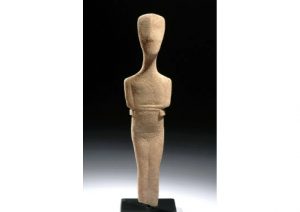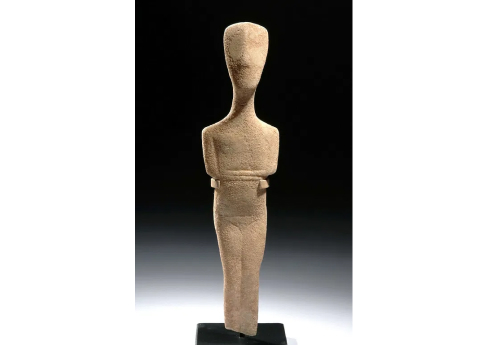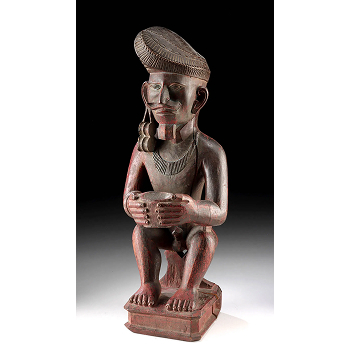Five For Friday: Artemis Gallery
Auction Daily: Please give our readers a brief introduction to the broad categories of ancient art and antiquities. What forms do these items take? And where are most of these items originally found?
Bob Dodge, Founder and Executive Director, Artemis Gallery: There are several categories of ancient art and antiquities.
The first is “ancient art.” Generally speaking, any art or artifact over 1,500 years old is considered “ancient art.” Examples come from European, African or Asian cultures and countries; these include Egypt, Rome, Greece, Persia, China, and India.
The second is “classical antiquities.” This category includes ancient art from cultures and countries around the Mediterranean Sea, including Greece, Egypt, Rome, and other ancient near-eastern cultures. Classical Antiquities date from early prehistoric civilizations to the “dark ages.”
The third is “pre-Columbian art.” This includes art and artifacts created prior to 1492, the year Columbus arrived in the New World. In many parts of Messo-America, that date is actually 1532. Examples originate from South, Central, and North America, as far north as Mexico.
And the fourth is “ethnographic art,” which is the art of Indigenous peoples usually from western or Pacific-based cultures, but also Africa. These date between about 1500 to the present day.
In most cases, ancient art was found in tombs and takes the form of items that would be used in the afterlife. This is pretty common across all cultures and all regions. As such, pottery utilitarian objects are perhaps the single most common items found – and by default, collected. We’ve all seen the incredible examples of Greek decorated pottery, but equally fine pottery objects were made in Egypt, Rome, the Middle East, Asia, and certainly in most Pre-Columbian cultures. In classical antiquity, we also find glass (including faience), bronzes, wood, carved stone, ivory, gold, and silver objects. In the pre-Columbian category, we find pottery, as well as gold and silver, textiles, carved wooden objects, shell, copper, jade, and other carved stones.
Auction Daily: Who collects antiquities and/or ancient and ethnographic art? How long have they been collecting, and what got them interested in these pieces?
Bob Dodge: The “average” collector is older, usually male (but certainly not always), highly educated, comes from a professional background, and has often had an interest in ancient art for many years. The one thing that sets apart collectors of ancient art from those who do not is not how wealthy they are, but how curious they are. They love art, science, history, and natural history. In most cases, they not only collect art and artifacts, but also things like dinosaur bones, meteorites, coins, gems and minerals, books, and more. I think the trigger for each collector is probably a bit unique, but the common thread is usually either traveling to see the great museums and ancient architecture of Europe or Egypt, or being a museum addict here in the US. Many collectors as late as the 1970’s could legally bring back ancient art as souvenirs from their travels.
Auction Daily: Tell us about your in-house testing lab and how that works. What percentage of the items prove not to be authentic?
Bob Dodge: Artemis Testing Lab is one of the only in-house, gallery-owned labs of its kind in the US. We use several pieces of equipment, but primarily our lab uses Thermoluminescence (TL) Testing and X-Ray Fluorescence (XRF). The TL process involves drilling very small holes into ancient pottery, catching the powder that comes out, and using a very expensive piece of equipment to measure how much radiation has been absorbed into the powder since the piece last exceeded 900 degrees – the temperature achieved during initial firing.
The XRF “gun” sends beams of X rays into objects, exciting the atoms. It then sends back data as to which atoms are excited from which elements and in what percentages. This allows us to see the elemental makeup of items to see if they are consistent with items known to be ancient. For example, most ancient bronzes are made of copper and tin but have other trace elements as well. We have charts showing what elements should be there and which should not. We can use the XRF to help determine the authenticity of metals, assist in fine-tuning the age of ancient ceramics, and assessing the type of stone an object is made from. We can see if an item is jade, or simply greenstone.
Of the hundreds of items we test annually, about 30% of all pottery tested is found to be of modern origin. Of all of the items tested using XRF technology, primarily metals, we are finding as many as 50% are modern. Before any collector starts to get anxious about those numbers, objects coming from major galleries and old collections experience far lower rates, and for many of the items we test, we expect negative outcomes. Our customers want and need confirmation of an item’s authenticity, and we are pleased to offer that service.
Auction Daily: What is the oldest item your company has ever handled? And what was the most extraordinary?
Bob Dodge: Because we handle meteorites and fossils, we can say we have handled objects over 4 billion years old, or fossils over 250 million years old. We have handled stone objects made by man that date back 400,000 years, and we have handled numerous stone hand axes made by Neanderthals, dating over 40,000 years old. The oldest pottery object we have handled was an incredibly simple bowl made of sun-dried clay with a human fist impression to create the “bowl.” It was about 8,000 years old and came from a small, ancient settlement outside of Tehran.
As for the most extraordinary, that is very subjective. However, when I first started collecting, it was a goal to someday own a Greek Cycladic marble idol. These idols can now fetch millions at auction, so not something I will probably ever be able to purchase for myself. But last year, we did have a superb example come in for auction. Standing only about 7 inches high, it sold in excess of $250,000. I may never own one, but I can now say I have handled one.
Auction Daily: And finally, what does it feel like handling something originally produced thousands – or more – years ago? How might that differ from handling a fine antique only a few hundred years old?
Bob Dodge: Holding something in your hands that was made 2,000+ years ago is almost surreal. First, you feel a strange connection to people of the past. You can sense that they loved, laughed, cried, and appreciated wonderful things just like we do, and then, of course, they died. Then you begin to wonder… How did this object survive? When was it found? How many people have appreciated it over the 100+ generations it has been around? What were the owners like? And what from our modern era will survive and be treasured 2,000 years from now?
I appreciate antiques and medieval objects and fine paintings and most forms of art. I love the feel and patinas of antique wood. 18th century bronzes are stunning, as are 19th century ceramics. We have handled works by Picasso and Warhol and Dali and Rivera, as well as several old masters, and these always give me a thrill. But none of these come close to the feeling I get when I hold a Greek vase, or pre-Columbian silver kero, or ancient Egyptian bronze figure or miniature Aztec stone carving. They are simply magical.
Artemis Gallery, the leading online gallery for authentic ancient and ethnographic art,Is located in Erie, CO. In business since 1993, the company also offers valuations and appraisals, estate liquidation, restoration, and authentication / TL-testing services. Every artifact sold by Artemis Gallery is guaranteed as presented and comes with a certificate of authenticity, indicating its culture, provenance and age. For more information, please visit their website.











